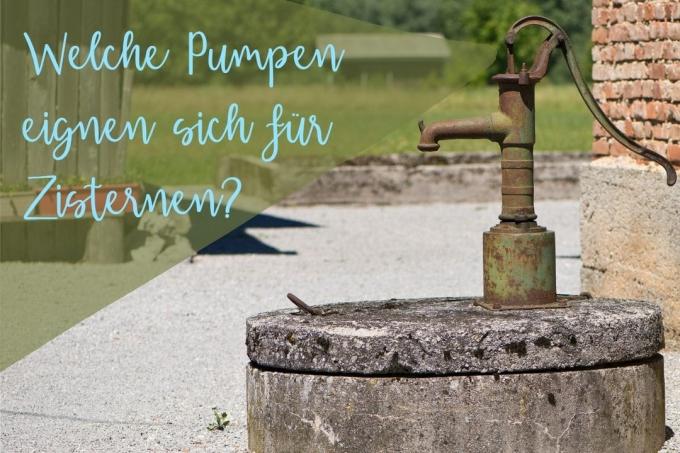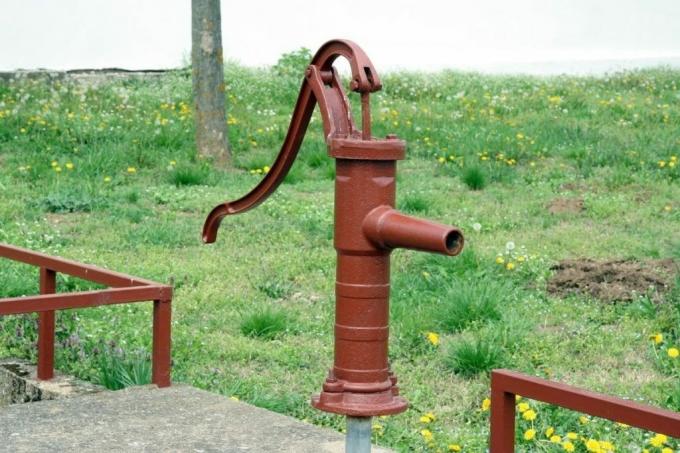
table of contents
- Requirements for the pump
- Which model is ideal?
- The centrifugal pump
- The pressure pump
- The submersible pump
- The handle pump
- frequently asked Questions
Irrigation takes up an enormous part of the gardening work. A cistern allows you to use rainwater for irrigation. However, the pump used should meet a number of requirements.
In a nutshell
- From a technical point of view, rainwater counts as gray or even dirty water because of the foreign substances it contains
- the centrifugal pump has established itself as the state of the art for rainwater today
- Suction pumps can be set up in a protected place next to the cistern
- Submersible pumps are very flexible, but cannot remain in the water permanently
Requirements for the pump
In order to determine which pump is ideal for your cistern and your specific application, you should However, first of all, consider the demands placed on the device by the specific form of use will:

- safe functionality with contaminated (rain) water
- Insensitivity to algae etc.
- Resistance to temperature fluctuations and weather influences
- Protection of all components against moisture (including connection cables, etc.), such as fog, rain, soil moisture
- Compatibility with common hose and pipe systems for garden irrigation
Which model is ideal?
Now that it is clear what a pump must be able to do for garden irrigation using a cistern, the essential question is which models meet the requirements.
Note: There are countless models of pumps with the necessary suitability on the market. Ultimately, however, these models can be traced back to a few functional principles. The list is therefore manageable and easy to control even for laypeople.
The centrifugal pump
Before the actual Pump types let's look at the technical functional principle of pressure generation. Because here a functional structure is used for almost all pumps suitable for garden irrigation: the so-called centrifugal pump.

functionality
An axially mounted impeller rotates and generates the required pressure via the blades of the wheel. Depending on the size of the blades and the entire impeller and the space provided between the impeller and housing, this technology is able to transport even larger dirt and foreign bodies without damage.
Strengths and weaknesses
This construction method impresses with its smooth running and thus a long service life. At the same time, a high delivery rate is achieved, which can also contain contaminated water including solids. With its simple construction, it is particularly low-maintenance and easy to remove from malfunctions. However, such a pump is only able to draw in water to a limited extent. Either the system must therefore be filled with water from the pump once before it is started up, or the suction path is at least limited in terms of its length.
One way of working - several types
Based on the technology of the centrifugal pump, at least two proven and widely used types of pumps suitable for garden irrigation have emerged:
The pressure pump
A widely used type of pump is the pressure pump. Usually placed free-standing, it has two connections: an inlet for the water to be pumped and an outlet for the discharge of the water. This pump is usually placed in an existing line connection between the cistern and the extraction point and combines a suction with a pushing function. The water is drawn in from the storage tank. From the exit of the device, the transport takes place via the pressure generated. An initial pre-filtering against dirt and foreign matter usually takes place directly at the inlet to the suction hose, where, for example, a sieve or a so-called “collecting basket” is installed.

Advantages:
- permanent installation possible
- high delivery rate
- no special precautions (e.g. B. particularly large access opening) at the cistern
- easy revisioning due to easily accessible installation locations
- no special technical requirements for sealing etc. of motor and power supply
Disadvantage:
- high effort in setting up and relocating
- high demand for accessories with suction and pressure hoses
The submersible pump
A submersible pump is a special type of waste water pump. It is not placed next to the cistern or set up between the water storage tank and the point of delivery. Instead, the entire pump technology is hung on a rope directly in the water to be pumped or placed on the bottom of the tank. All that is needed is a pressure hose leading away from the unit in order to actually transport the water to the desired place of consumption.

Advantages:
- easily and quickly relocated
- no complex suction hoses necessary
- No filling necessary due to the location directly in the water
- very little noise due to the sound-absorbing effect of the water
Disadvantage:
- Size and delivery rate are limited due to manageability when hanging in the tank
- Complete removal necessary for revision or repair
- correspondingly large access to the cistern is required
- if it remains in the water reservoir for a long time, there is a risk of rapid growth of algae and contamination
The handle pump
Finally, a variant without a motor should be briefly introduced at this point: the lever pump. In contrast to the other motor-driven models, this is not a centrifugal pump, but a piston pump. Similar to an air pump, each time the pump arm moves, a filling of the piston attached below is conveyed. With the countermovement, the piston fills up again and the process starts all over again. The location must be selected directly above the cistern, as the downward-pointing standpipe of the pump must point directly into the water.

Note: This technology can be found in the vast majority of hand-operated water pumps. With appropriate maintenance, it is almost indestructible. Some models have been in operation for well over 100 years.
Advantages:
- no electrical connection required
- environmentally friendly as it is emission-free
- very robust and low-maintenance
Disadvantage:
- high expenditure for conveying capacity
- simple relocation not possible
- no automated operation possible
frequently asked Questions
Of course, with the appropriate filters, diaphragm pumps also work for pumping water in the garden. However, these devices suffer from dirt and algae formation much more quickly. In addition, their production capacity is comparatively low.
Among the existing pumps there are certainly still isolated pumps that use piston technology. In current models, on the other hand, this type of construction is no longer found, as the large number of mechanical components would be too expensive and would require too much maintenance.
The most interesting thing here is certainly how much water a device can transport per minute. However, this value also depends on the hoses used and the delivery height and distance. Therefore, the only thing left to do is to use the motor power to narrow down the dimensions: Common pumps for garden use usually range between 2,000 and 4,000 watts.


